The NBA Draft's Biggest Riser: Who is Ben Sheppard?

Ben Sheppard is a name that is rapidly gaining first-round steam as the 2023 NBA Draft approaches on Thursday, June 22.
The twenty-one year old senior from Belmont University has reportedly worked out for seven teams thus far, each of which have at least one first round pick.
He’s likely to be drafted anywhere in the 14-40 range, which lines up with the picks available to teams that have brought him in for workouts: Atlanta Hawks (No. 15), Golden State Warriors (No. 19), Indiana Pacers (No. 26; No. 29; No. 32), New Orleans Pelicans (No. 14), Portland Trail Blazers (No. 23), Sacramento Kings (No. 24; No. 38), and the Utah Jazz (No. 16; No. 28).
So, what is so intriguing about Sheppard? Let’s discuss it below.
Physical Profile
To start, Sheppard has a similar physical profile to both Josh Hart and Quentin Grimes, the latter of whom he shares a multitude of on-court similarities with as well.
Prospect Name | Height w/o Shoes | Weight (lbs) | Wingspan | Maximum Vertical |
|---|---|---|---|---|
Ben Sheppard | 6’5.25” | 195 | 6’7.75” | 35.5" |
Josh Hart | 6'3.75" | 209 | 6'8.25" | 35.5" |
Quentin Grimes | 6'4" | 210 | 6'7.75" | 36" |
Immediate Offensive Projection: Stationary Shooter
Part of what makes Sheppard increasingly likely to hear his name called in the first-round is his relatively high floor, as he has the skills to quickly fulfill both an offensive and defensive role within his first season or two in the NBA.
The offensive role he is most likely to fulfill is that of a stationary shooter, where he will be primarily put in catch-and-shoot situations beyond the arc.
Catch-and-Shoot Threes
The most important component of fulfilling the role of a stationary shooter is being able to hit catch-and-shoot threes consistently. Sheppard shot an impressive 40.4% on catch-and-shoot threes at Belmont on 151 attempts and finished in the 85th percentile in catch-and-shoot points per shot (PPS) among all qualified Division 1 players last season. He has a smooth energy transfer and quick release which indicate that, while the results are good, so are his processes to getting those results.
However, it should be noted that Sheppard is significantly better in the catch-and-shoot when uncontested. In fact, Sheppard converted 34.4% of his catch-and-shoot threes when guarded compared to converting 49.2% of his unguarded catch-and-shoot threes. This is evident on film as well, as his misses usually result from his shooting hand being pushed off-balance due to being contested. Regardless, spot-up shooting will likely be an immediate strength of his at the next level.
Attacking Closeouts
Since Sheppard is a significant catch-and-shoot threat from three, the next step to fulfilling the role of a stationary shooter is the ability to attack closeouts. This is a strength of Sheppard’s, as he attacks closeouts with a quick first step and creates advantages in this area fairly consistently.
Struggles Finishing Over Length
Despite finishing a healthy 61% at the rim on 148 attempts, one area that Sheppard should improve upon to immediately fulfill a stationary shooter role is his ability to finish over length. Sheppard showed slight improvement finishing at the rim as the season went on, converting 67% (26/39) of his rim attempts in February and March.
Potential Offensive Role: Movement Shooter
With the expectation being that Sheppard can move smoothly into a stationary shooter role to begin his career, one path of development Sheppard may take is becoming a movement shooter. Sheppard uses his speed to relocate and make himself open off-ball, then excels at squaring to the basket and setting his feet to finish the play.
One area of movement shooting Sheppard could look to improve upon to reduce the number of misses is ensuring he stays balanced when he comes off of screens or curls to catch the ball. His few misses on movement shots are almost solely caused by him fading away and being slightly off-balance.
This movement shooting strength of his, despite occurring less frequently at Belmont, can be applied to shooting off handoffs or coming off screens as well.
Being that Sheppard would be mostly in an off-ball role as a movement shooter, Sheppard provides additional value by being a smart cutter at times as well. He has the quickness and footwork to cross up a defender without needing the ball in his hands.
Potential Offensive Role: Secondary Ball-Handler
An alternate offensive developmental path Sheppard could take is becoming a secondary ball-handler. In this role, Sheppard would take the pressure off of his team's primary ball-handler, occasionally being put into P&R situations, creating rim pressure, and initiating the offense. Growing up as a point guard, Sheppard is no stranger to creating for his teammates.
Creating Rim Pressure
If Sheppard develops into a secondary ball-handler, Sheppard will need to consistently create rim pressure. Although he doesn't project to consistently create rim pressure at the NBA level immediately, Sheppard has shown the potential to create rim pressure with a combination of a quick first step, downhill speed and a hint of craft within his handle at Belmont. If he continues to develop this, it could be another way to create offensive value for him later in his career and fulfill the role of a secondary ball-handler.
Playmaking Off Drives and Accuracy as a Passer
As mentioned above, Sheppard has shown potential creating plays for others off of drives and being an accurate passer. This will be an important component of his game if he's developed as a secondary ball-handler.
Self-Creation and Counter
Sheppard has also shown flashes of self-creation and a turnaround-jumper counter on drives. Although he has not consistently created for himself at Belmont, these flashes (and more importantly the turnaround jumper) are encouraging.
Potential as a Pick-and-Roll Ball-Handler
Perhaps most importantly, Sheppard has the potential to provide quality possessions as the P& Ball-Handler and finished in the 89th percentile (1.04 Points Per Possession on 222 possessions) in pick-and-roll ball-handling and passes on Synergy. His ability to create for others out of the pick-and-roll will be important to grow if he develops as a secondary ball-handler.
Sheppard has also shown the potential to get to his own shot when left open in the pick-and-roll, either in the midrange or beyond the three-point line if given space.
Immediate Defensive Role: Chaser
While Sheppard can provide value for an NBA team offensively immediately in catch-and-shoot situations, he has the micro-skills to immediately fulfill the defensive role of a chaser in the NBA. As a chaser, Sheppard will be responsible for stopping players like him: movement shooters and off-ball cutters.
Off-Ball Screen Navigation
One of Sheppard's biggest strengths is his off-ball screen navigation, where his speed is on full display. He also does a great job of making himself skinny to chase shooters and shuts down after timeout plays or actions before they begin.
Awareness of Passing Lanes
Although many of these clips are not within the action of chasing, Sheppard has a knack for garnering steals in passing lanes. Being aware of passing lanes is a key component of being an impactful chaser in the NBA.
Needs to Improve His Technique on Closeouts
The one area Sheppard must improve in order to fulfill the role of a chaser is his closeouts. Too often he allows for a driving lane due to the angle he approaches with, doesn't impact the shot quality, or leaves his feet on pump fakes. Most of this relies on technique, not ability. Therefore, this should not deter him from fulfilling the role of a chaser within his first season.
Potential Defensive Role: POA Defender
Although I think it is likely that Sheppard sticks to his role as a chaser, he also has the potential to become a point-of-attack defender. Even if he's unable to consistently guard the opposing team's primary ball-handler, Sheppard's lateral quickness and on-ball screen navigation will be valuable defensively regardless.
Lateral Quickness
Sheppard is an above-average on-ball defender who displays lateral quickness.
At times, however, Sheppard can give up an advantage when he relies on using his hands rather than sliding his feet. Again, this is more technique than lack of ability and is fixable at the next level.
On-Ball Screen Navigation
Similar to his off-ball screen navigation, Ben Sheppard uses his speed and ability to make himself skinny to navigate on-ball screens. This is important if he develops into a point-of-attack defender, where he figures to face many pick-and-roll situations.
Improving Strength
One area Sheppard has room for improvement in is improving his upper-body strength. There are times on drives or navigating on-ball screens where Sheppard will let up an advantage due to getting stuck behind a screen or isn't strong enough to hold his ground against a bigger driver.
Miscellaneous Strengths: Transition Offense and Defensive Rebounding
Two miscellaneous strengths of Ben Sheppard's game that one could argue go hand-in-hand are his defensive rebounding and his ability to initiate a fast break in transition. Sheppard was in the 76th percentile in transition PPP (1.192 PPP) and had a 15.4 DREB% this past season.
Interestingly enough, the only two players in this draft with the below requirements were Sheppard and Brandin Poziemski:
Usage % ≥ 25
Defensive Rebounding % ≥ 15
Assist % ≥ 15
Turnover % ≤ 15
3P FG ≥ 0.4
FG% at rim ≥ 0.6
Another player who had met these same thresholds in the past: Josh Hart.
Conclusion
Overall, Sheppard projects immediately as a stationary shooter offensively who can utilize his quick first-step to attack closeouts and provide opportunities to create plays for others off of these drives. He has clear potential as a movement shooter and has shown enough flashes of both passing ability and creating rim pressure to be developed as a secondary ball-handler. His ability to finish over length may prove to be an X-factor in how impactful he can be in his rookie season.
Defensively, Sheppard is fantastic at navigating screens off-ball and, assuming his technique when conducting defensive closeouts improve, can fulfill this role early in his career. He's laterally quick but should improve his upper-body strength to ensure he can be as impactful as possible on-ball defensively. Combine this with an ability to navigate on-ball screens, and he has the potential to provide reps as the POA defender when needed later in his career.
Final Grade: Picks 16-25
Want to join the discussion? Like Draft Digest on Facebook and follow us on Twitter to stay up to date on all the latest NBA Draft news. You can also meet the team behind the coverage.
